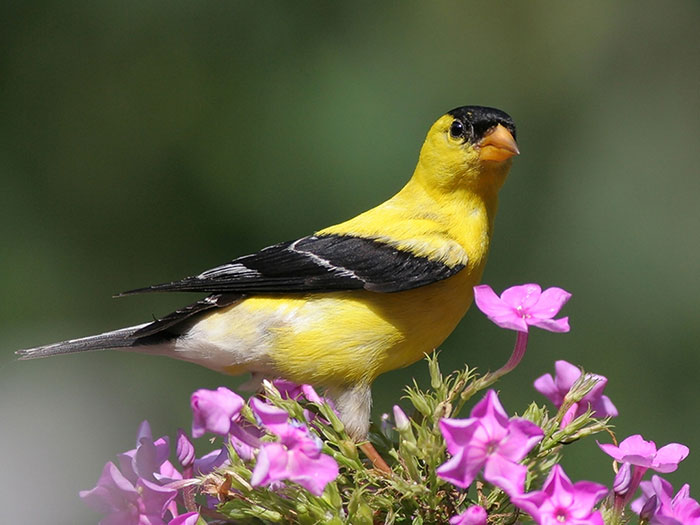
New Jersey is a northeastern U.S. state whose terrain consists of highlands, Appalachian ridge and valley, Newark basin piedmont, inner coastal plain, and outer Coastal plain. It’s a smaller state with a population of 9.267 million and an 8,722 sq mile size.
New Jersey state bird is the American Goldfinch. These are very common birds that are loved by many. American Goldfinches are small finches with long wings, short, conical bills, small heads, and short, notched tails.
On this page
New Jersey State Bird
The American Goldfinch became a state bird of New Jersey on June 8th, 1935. Legislators made it the official state bird under Title 52, Section 52:9A-1. It does not contain the reason why the bird is the official state bird, but one can assume it’s due to its bright and cheerful appearance, as well as its commonness in the state.
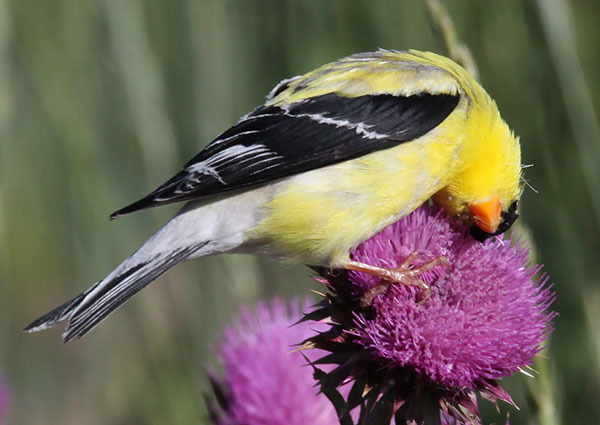
Additionally, these birds entertain New Jersey residents often with their songs. Their love of the allergy-inducing weed seeds probably made the residents love the tiny avian even more!
Fun Facts about American Goldfinches
- The American Goldfinch is the only species of finch that molts 2 times a year. These birds first molt in the spring; this is when males get their bright yellow feathers. The second molt is at the end of summer; this is when their darker feathers come in.
- The American Goldfinch is the state bird of Iowa and Washington as well.
- When an American Goldfinch breeds for the first time, they begin nesting at a minimum of two weeks later than adults who are experienced.
- American Goldfinches are dedicated vegetarians. These birds only deviate from this diet when they accidentally swallow an insect.
- You can attract American Goldfinches by planting Sunflowers and Purple Coneflowers, some of their favorite snacks.
- To stay warm in the winter, American Goldfinches are known to bury themselves under the snow and make a cozy sleeping cavity.
- There are more male American Goldfinches than females. There are more males because they have longer lifespans.
- The oldest recorded American Goldfinch lived to be at least 10 years and 5 months old.
- American Goldfinches weave nesting material so tight that the nests are able to hold water temporarily.
- American Goldfinches get their colorful plumage from their diet. Carotenoid pigments are found in the plants that they eat, which gives them their colorful appearance.
Identification
The American Goldfinch is a small species of finch. They have short, notched tails, short, conical bills, long wings, and a small head. American Goldfinches are smaller than Tufted Titmice.

© Alan D. Wilson
Adult male American Goldfinches have black foreheads, black wings with white markings, white patches both above and below the tail, and are bright yellow overall in the spring and early summer.
Adult female American Goldfinches are paler yellow underneath and olive above. In the winter, both males and females are unstreaked brown, drab, and have blackish wings with two faint wing bars.
Both male and female American Goldfinches are 4.3 to 5.1 inches long, weigh 0.4 to 0.7 ounces, and have a wingspan of 7.5 to 8.7 inches.
What do American Goldfinches eat?
American Goldfinches primarily consume seeds; it’s rare to see them consume anything else. The main types of seeds they eat include thistle, sunflower, grass seeds, and asters.
If you would like to attract these birds to your yard, you’re in luck! American Goldfinches are known to visit bird feeders as long as you offer the right seeds. To encourage these finches to visit your yard, it’s highly recommended that you plant native composite plants like thistles and milkweed.
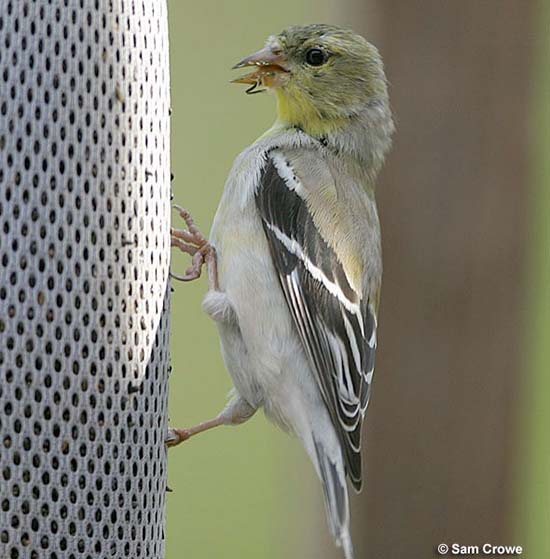
Goldfinches will eat from almost any bird feeder, including hanging, platform, and hopper feeders. Some bird species mind feeders that sway in the wind, but the American Goldfinch is not one of them.
Additionally, if you find that American Goldfinches get spooked by larger birds when visiting your feeders, you can sprinkle seed on the ground. They’re happy to feed underneath feeders. They’re most attracted to sunflower seeds and Nyjer, so be sure to add them to your feeding station if you want to attract these birds.
Call
Male American Goldfinches are more vocal than females. They sing variable, long sequences of warbles and twitters that can be seconds long. T
he phrases and notes they produce are variable but also repeated in what seems to be a random order. A cool thing about these birds is that they continue to learn different song patterns throughout their lives.
The American Goldfinch’s most common call is its contact call. Contact calls are often produced in flight. It sounds like these finches are quietly saying po-ta-to-chip with an even tempo.
Additionally, American Goldfinches sometimes give rough threat calls when in the nest or feeding in flocks.
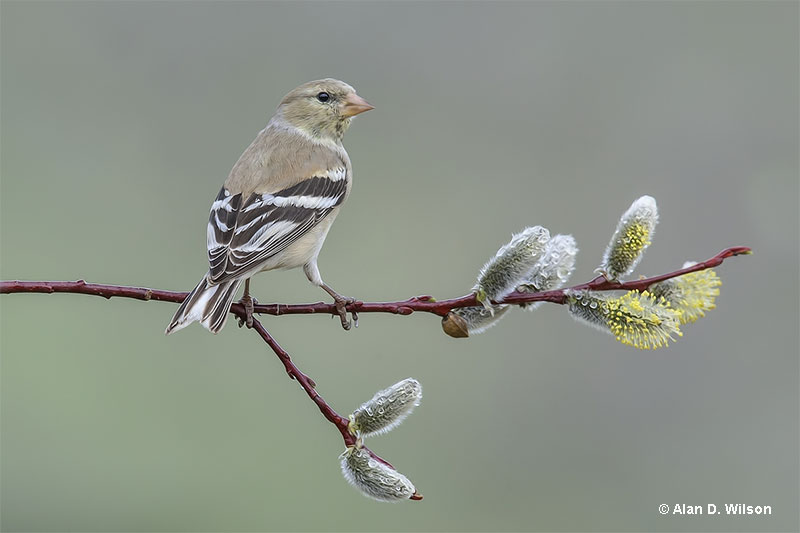
© Alan D. Wilson
Male birds make a courtship call when landing near a female in the spring and early summer. A burst of song often follows this call.
Female birds taking care of nestlings make a quick sequence of high-pitched notes when they hear their mate approaching. When sitting in their nest, they’ll commonly produce a two-parted, loud bay-bee call if they feel like they’re in danger.
Behavior
American Goldfinches are very acrobatic and active birds. You can commonly see them balancing on thistle seedheads, dandelions, and other plants to pick seeds. They often make their po-ta-to-chip calls when flying. They have a bouncy flight that’s very obvious.
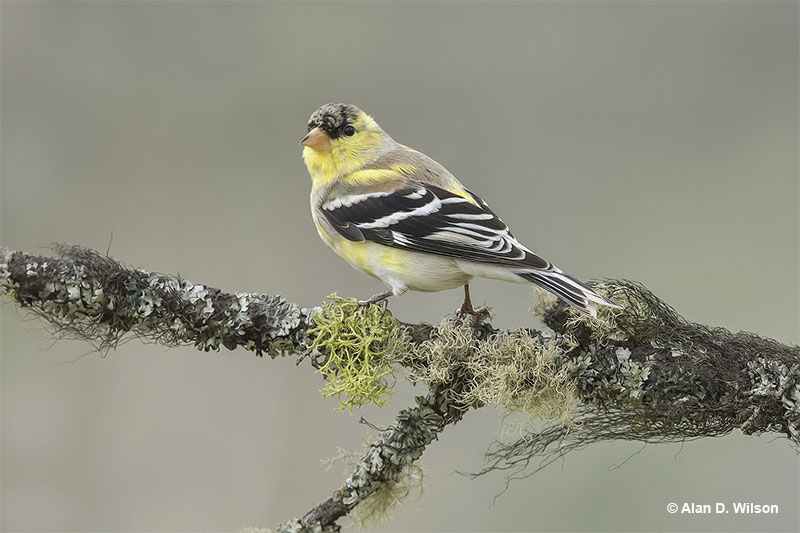
© Alan D. Wilson
Male birds start singing exuberantly during the spring, but mated pairs do not start nesting until mid-summer.
In the summer is when thistles and other weeds have begun producing seeds. Goldfinches are not known to participate in mobbing predators with other songbirds.
See more – Most common birds of New Jersey
Frequently Asked Questions
What is the state bird of New Jersey?
The state bird of New Jersey is the American Goldfinch, also known as the Eastern Goldfinch.
What is the state flower and animal of New Jersey?
The state flower of New Jersey is the Common Blue Violet. The state mammal of New Jersey is the Horse and the state reptile is the Bog Turtle.
When did the American Goldfinch become the state bird of New Jersey?
The American Goldfinch became a state bird of New Jersey on June 8th, 1935.

